Effect of Mo Content on In-Situ Anisometric Grains Growth and Mechanical Properties of Mo2FeB2-Based Cermets
Abstract
:1. Introduction
2. Materials and Methods
2.1. Raw Materials and Composition Design
2.2. Fabrication Process
2.3. Characterization
3. Results and Discussion
3.1. Microstructure Evolution
3.2. Mechanical Properties
4. Conclusions
- Grain coarsening of Mo2FeB2-based cermets is controlled by interface reaction.
- With Mo content increasing from 43.5 wt.% to 49.5 wt.%, Mo2FeB2 content increases while particle size and the relative density of the cermets decreases, and particles change from long rod shape to near-equiaxed shape. When Mo content is 47.5 wt.%, the cermets with dense microstructure, normal development of particles and uniform particle distribution can be obtained. In addition, the cermets with 47.5 wt.% Mo content exhibit a relatively small particle size of 2.03 μm.
- With Mo content increasing, hardness and TRS of cermets first increase and then decrease, while fracture toughness gradually decreases. When Mo content is 47.5 wt.%, hardness and TRS reach the maximum, being HRA 87.7 and 1334.3 Mpa, respectively. The comprehensive mechanical properties of cermets at 47.5 wt.% Mo content are the best.
- The optimal raw material ratio for the preparation of Mo2FeB2-based cermets in this study is determined to be 47.5 wt.% Mo–6.0 wt.% B-Fe. This study provides experimental basis for batching in preparing Mo2FeB2-based cermets, which is conducive to further application and promotion in industry.
Author Contributions
Funding
Institutional Review Board Statement
Informed Consent Statement
Data Availability Statement
Conflicts of Interest
References
- Zhang, H.; Pan, Y.; Zhang, Y.; Lian, G.; Cao, Q.; Yang, J.; Ke, D. Effect of laser energy density on microstructure, wear resistance, and fracture toughness of laser cladded Mo2FeB2 coating. Ceram. Int. 2022, 48, 28163–28173. [Google Scholar] [CrossRef]
- Cao, Z.; Jian, Y.; Huang, Z.; Xu, L.; Fan, J. High-temperature cyclic oxidation behavior and mechanism of Mo2FeB2-based cermets with various boron contents. Corros. Sci. 2021, 190, 109665. [Google Scholar] [CrossRef]
- Cao, Z.; Jian, Y.; Yao, X.; Deng, J.; Zhou, Y.; Wang, J.; Huang, Z. Dual effects of Cr doping on the high-temperature oxidation behavior of Mo2FeB2-based cermets. Corros. Sci. 2022, 204, 110358. [Google Scholar] [CrossRef]
- Takagi, K.I. Development and application of high strength ternary boride base cermets. J. Solid State Chem. 2006, 179, 2809–2818. [Google Scholar] [CrossRef]
- Takagi, K.I. High tough boride base cermets produced by reaction sintering. Mater. Chem. Phys. 2001, 67, 214–219. [Google Scholar] [CrossRef]
- Ivanov, M.B.; Vershinina, T.N.; Ivanisenko, V.V. The effect of composition and microstructure on hardness and toughness of Mo2FeB2 based cermets. Mater. Sci. Eng. A 2019, 763, 138117. [Google Scholar] [CrossRef]
- Yuan, B.; Zhang, G.-J.; Kan, Y.-M.; Wang, P.-L. Reactive synthesis and mechanical properties of Mo2NiB2 based hard alloy. Int. J. Refract. Met. Hard Mater. 2010, 28, 291–296. [Google Scholar] [CrossRef]
- Wu, H.; Zheng, Y.; Zhang, J.; Zhang, G.; Ke, Z.; Xu, X.; Lu, X.; Zhou, W. Preparation of Mo2FeB2-based cermets with a core/rim structure by multi-step sintering approach. Ceram. Int. 2019, 45, 22371–22375. [Google Scholar] [CrossRef]
- Zhang, L.; Huang, Z.F.; Liu, Y.; Shen, Y.; Li, K.; Cao, Z.; Ren, Z.; Jian, Y. Effect of Ni content on the microstructure, mechanical properties and erosive wear of Mo2NiB2–Ni cermets. Ceram. Int. 2019, 45, 19695–19703. [Google Scholar] [CrossRef]
- Zhang, L.; Huang, Z.F.; Shen, Y.P.; Li, K.M.; Cao, Z.; Jian, Y.X.; Ren, Z.J. High-temperature compressive properties and tribological behaviour of Mo2NiB2–Ni cermets. Ceram. Int. 2019, 45, 18413–18421. [Google Scholar] [CrossRef]
- Zhang, T.; Yin, H.Q.; Zhang, C.; Zhang, R.J.; Yang, Z.; Elder, S.; Jiang, X.; Deng, Z.; Yang, G.Q.; Zheng, Q.J.; et al. Synthesis and microstructure evolution of WCoB based cermets during spark plasma sintering. Ceram. Int. 2019, 45, 17536–17544. [Google Scholar] [CrossRef]
- Zhang, L.; Huang, Z.; Liu, Y.; Shen, Y.; Li, K.; Cao, Z.; Ren, Z.; Jian, Y. Effects of Mechanical Ball Milling Time on the Microstructure and Mechanical Properties of Mo2NiB2-Ni Cermets. Materials 2019, 12, 1926. [Google Scholar] [CrossRef] [PubMed]
- He, L.; Gao, Y.; Li, Y.; Liu, Z.; Zhai, W.; Yuan, W.; Chen, W.; Yan, W. An effective way to solve the abnormal oxidation behavior of Fe in Ti(C,N)-304ss cermet. Corros. Sci. 2019, 155, 164–172. [Google Scholar] [CrossRef]
- Haizhou, Y.; Wenjun, L.; Ping, F.; Yong, Z. Synthesis and microstructure evolution during vacuum sintering of Mo2FeB2 based cermets. Int. J. Refract. Met. Hard Mater. 2014, 45, 48–52. [Google Scholar] [CrossRef]
- Yamasaki, Y.; Nishi, M.; Takagi, K.i. Development of very high strength Mo2NiB2 complex boride base hard alloy. J. Solid State Chem. 2004, 177, 551–555. [Google Scholar] [CrossRef]
- Ren, X.; Yu, L.; Liu, Y.; Li, H.; Wu, J.; Liu, Z. Effects of extra boron addition on the liquid-state sintering process and properties of hard Mo2FeB2-based cermets. Int. J. Refract. Met. Hard Mater. 2016, 61, 207–214. [Google Scholar] [CrossRef]
- Pang, X.; Yong, Z.; Shao, W.; Qiu, W. Effect of Mn on valence-electron structure and properties of hard phase in Mo2FeB2-based cermets. Int. J. Refract. Met. Hard Mater. 2009, 27, 777–780. [Google Scholar]
- Yu, H.; Yong, Z.; Liu, W.; Zheng, J.; Xiong, W. Effect of Mn content on the microstructure and mechanical properties of Mo2FeB2 based cermets. Int. J. Refract. Met. Hard Mater. 2010, 28, 286–290. [Google Scholar] [CrossRef]
- Yang, F.; Wu, Y.; Han, J.; Meng, J. Microstructure, mechanical and tribological properties of Mo2FeB2 based cermets with Mn addition. J. Alloy. Compd. 2016, 665, 373–380. [Google Scholar] [CrossRef]
- Shen, Y.p.; Huang, Z.f.; Xiao, P.; Zhang, L.; Li, K.m.; Cao, Z.; Jian, Y. Sintering mechanism, microstructure evolution and nanomechanical properties of Cr-added Mo2FeB2 based cermets. Ceram. Int. 2020, 46, 15482–15491. [Google Scholar] [CrossRef]
- Yu, H.; Zheng, Y.; Liu, W.; Zheng, J.; Xiong, W. Effect of V content on the microstructure and mechanical properties of Mo2FeB2 based cermets. Mater. Des. 2010, 31, 2680–2683. [Google Scholar] [CrossRef]
- Zhang, J.; Zheng, Y.; Zhou, W.; Zhang, G.; Ke, Z.; Dong, Z.; Feng, P. Effects of Cr content on the microstructure and mechanical properties of Mo2FeB2-based cermets prepared via vacuum sintering. Vacuum 2018, 155, 509–513. [Google Scholar] [CrossRef]
- Shen, Y.; Huang, Z.; Zhang, L.; Li, K.; Cao, Z.; Xiao, P.; Jian, Y. Sintering Mechanism, Microstructure Evolution, and Mechanical Properties of Ti-Added Mo2FeB2-Based Cermets. Materials 2020, 13, 1889. [Google Scholar] [CrossRef]
- Yu, H.; Liu, W.; Zheng, Y. Effect of carbon content on the microstructure and mechanical properties of Mo2FeB2 based cermets. Int. J. Refract. Met. Hard Mater. 2011, 29, 724–728. [Google Scholar] [CrossRef]
- Shen, Y.; Huang, Z.; Zhang, L. Effect of milling time on the microstructure and mechanical properties of Mo2FeB2 based cermets. Materials Research Express 2017, 4, 106518. [Google Scholar] [CrossRef]
- Yu, H.; Liu, W.; Zheng, Y. Microstructure and mechanical properties of liquid phase sintered Mo2FeB2 based cermets. Mater. Des. 2011, 32, 3521–3525. [Google Scholar] [CrossRef]
- Shen, Y.; Huang, Z.; Jian, Y.; Yang, M.; Li, K. Investigation on microstructure and mechanical properties of Mo2FeB2 based cermets with and without PVA. Mater. Res. Express 2018, 5, 036505. [Google Scholar] [CrossRef]
- Yu, H.; Zheng, Y.; Liu, W.; Pang, X.; Zheng, J.; Xiong, W. Effect of Mo/B atomic ratio on the microstructure and mechanical properties of Mo2FeB2 based cermets. Int. J. Refract. Met. Hard Mater. 2010, 28, 338–342. [Google Scholar] [CrossRef]
- Ide, T.; Ando, T. Reaction sintering of an Fe-6 wt pct B-48 wt pct Mo alloy in the presence of liquid phases. Metall. Trans. A 1989, 20, 17–24. [Google Scholar] [CrossRef]
- Lee, D.D.; Kang, S.J.L.; Yoon, D.N. Mechanism of grain growth and α-β′ transformation during liquid-phase sintering of β′-sialon. J. Am. Ceram. Soc. 1988, 71, 803–806. [Google Scholar] [CrossRef]
- Huang, Z.; Xing, J.; Gao, Y. Effect of Boron on the Microstructure and Properties of Semisolid Hypereutectic High Chromium Cast Iron. Rare Met. Mater. Eng. 2011, 40, 244–247. [Google Scholar]
- Ren, X.; Fu, H.; Xing, J.; Yi, Y. Effect of solidification rate on microstructure and toughness of Ca-Ti modified high boron high speed steel. Mater. Sci. Eng. A 2019, 742, 617–627. [Google Scholar] [CrossRef]
- Jian, W.; Xing, J.; Qiu, Z.; Zhi, X.; Cao, L. Effect of fabrication methods on microstructure and mechanical properties of Fe3Al-based alloys. J. Alloy Compd. 2009, 488, 117–122. [Google Scholar]
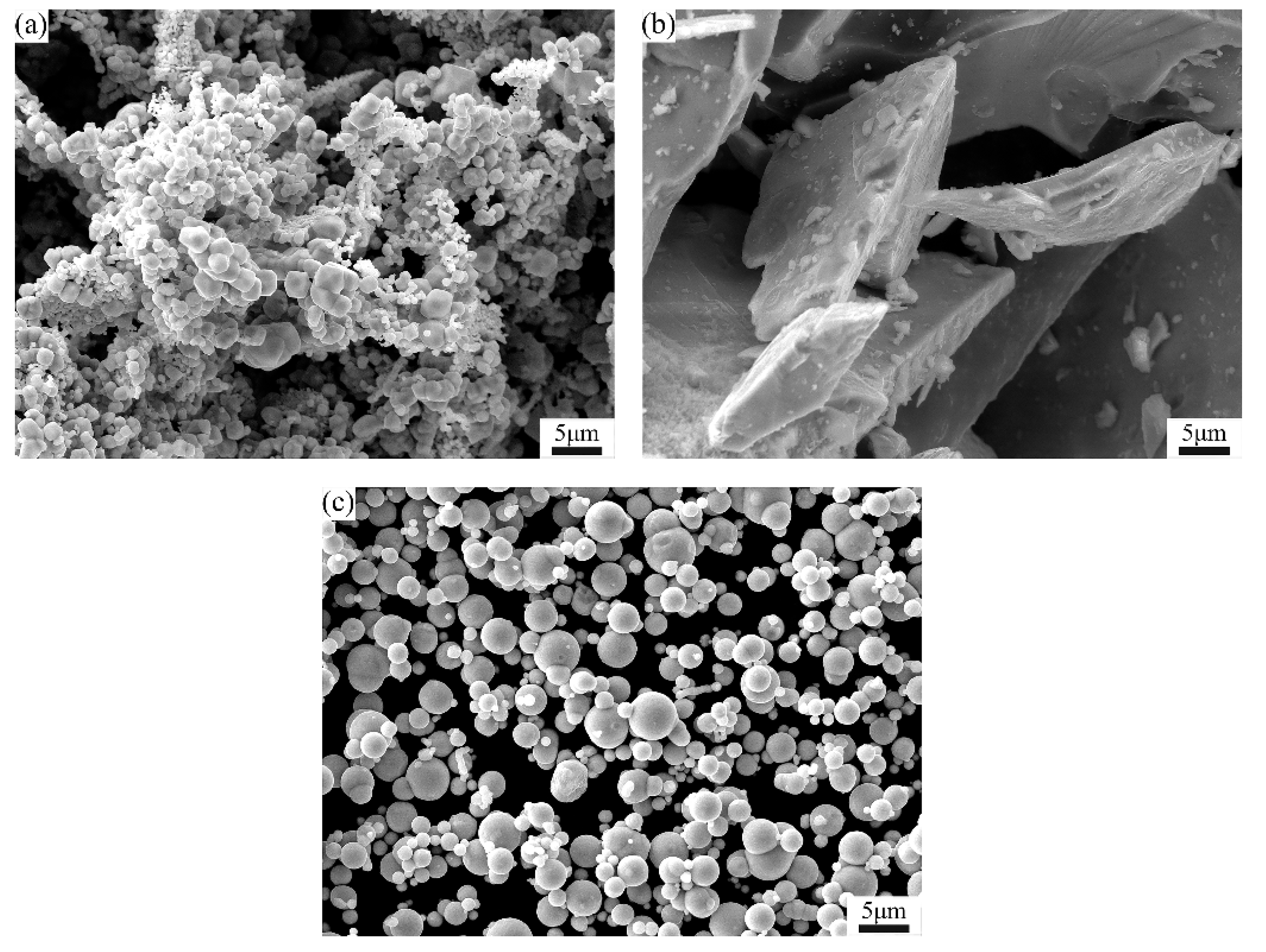
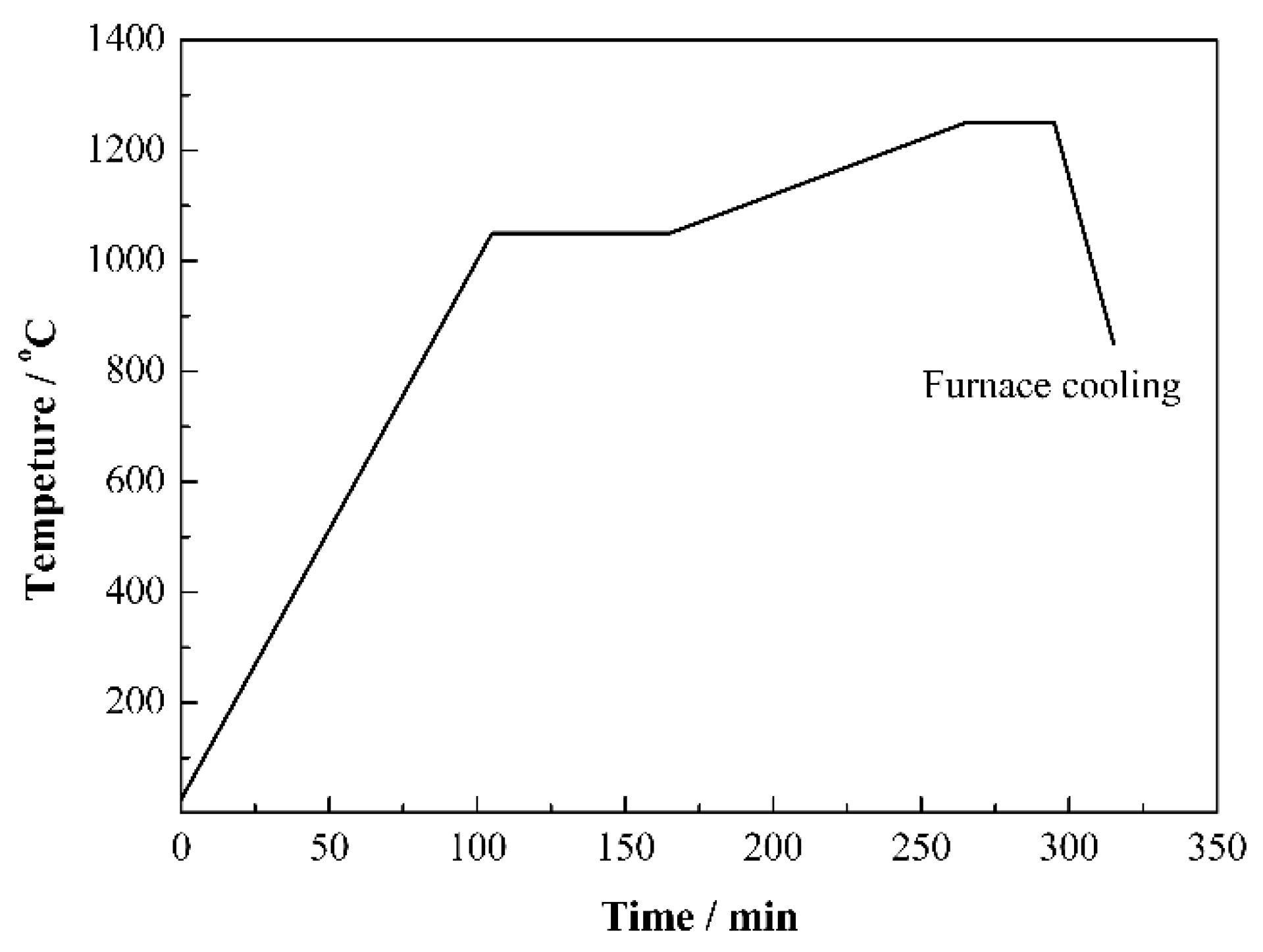

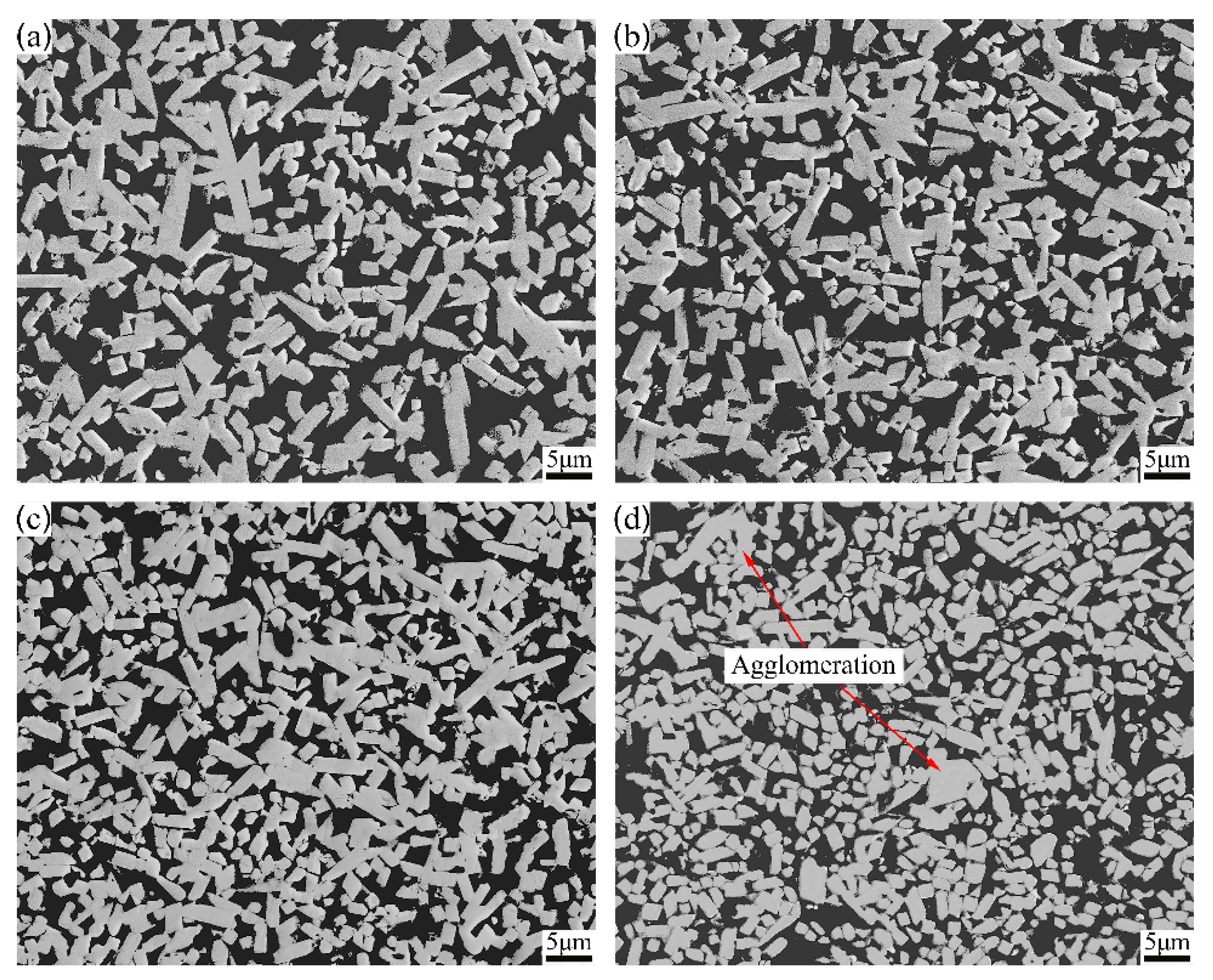


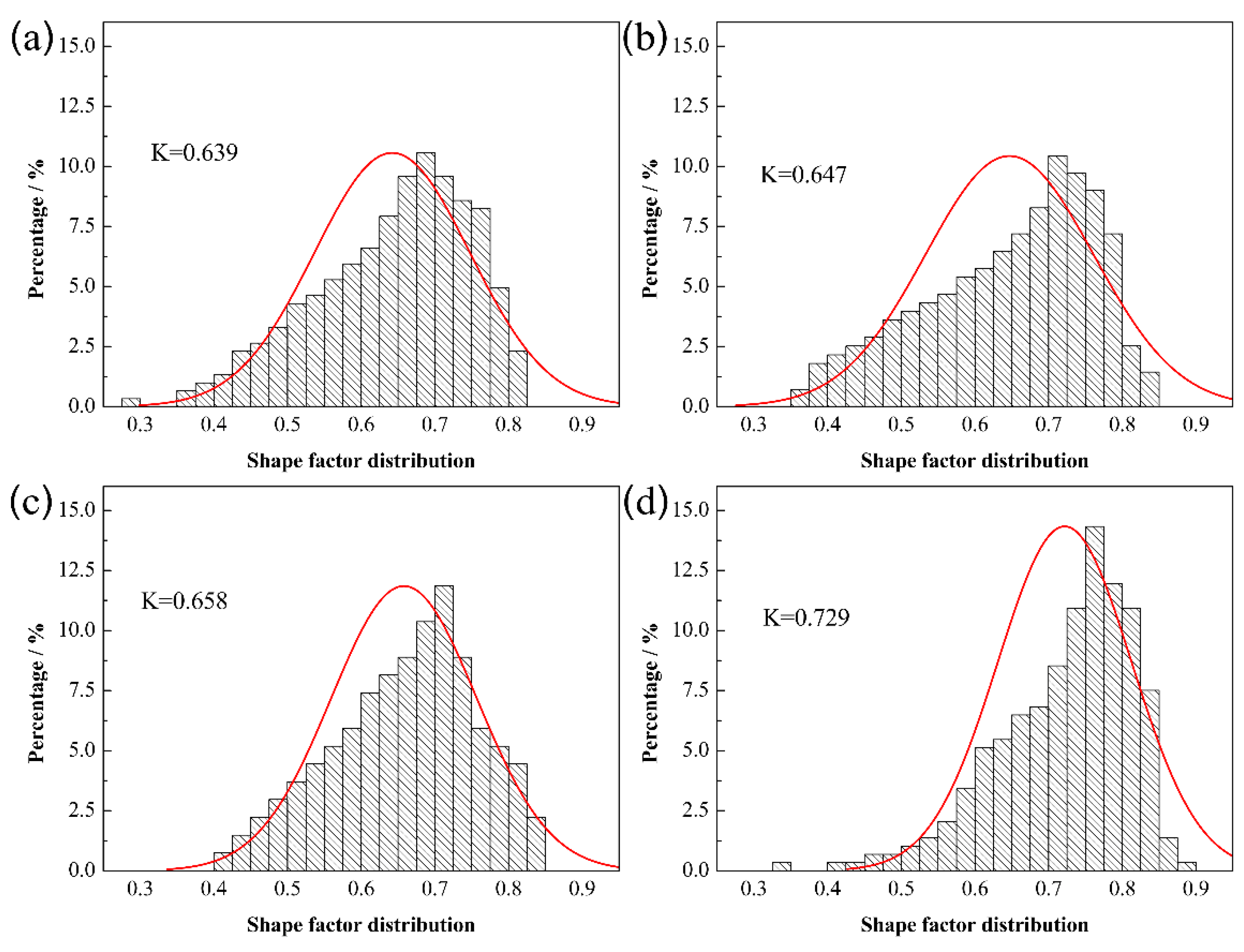
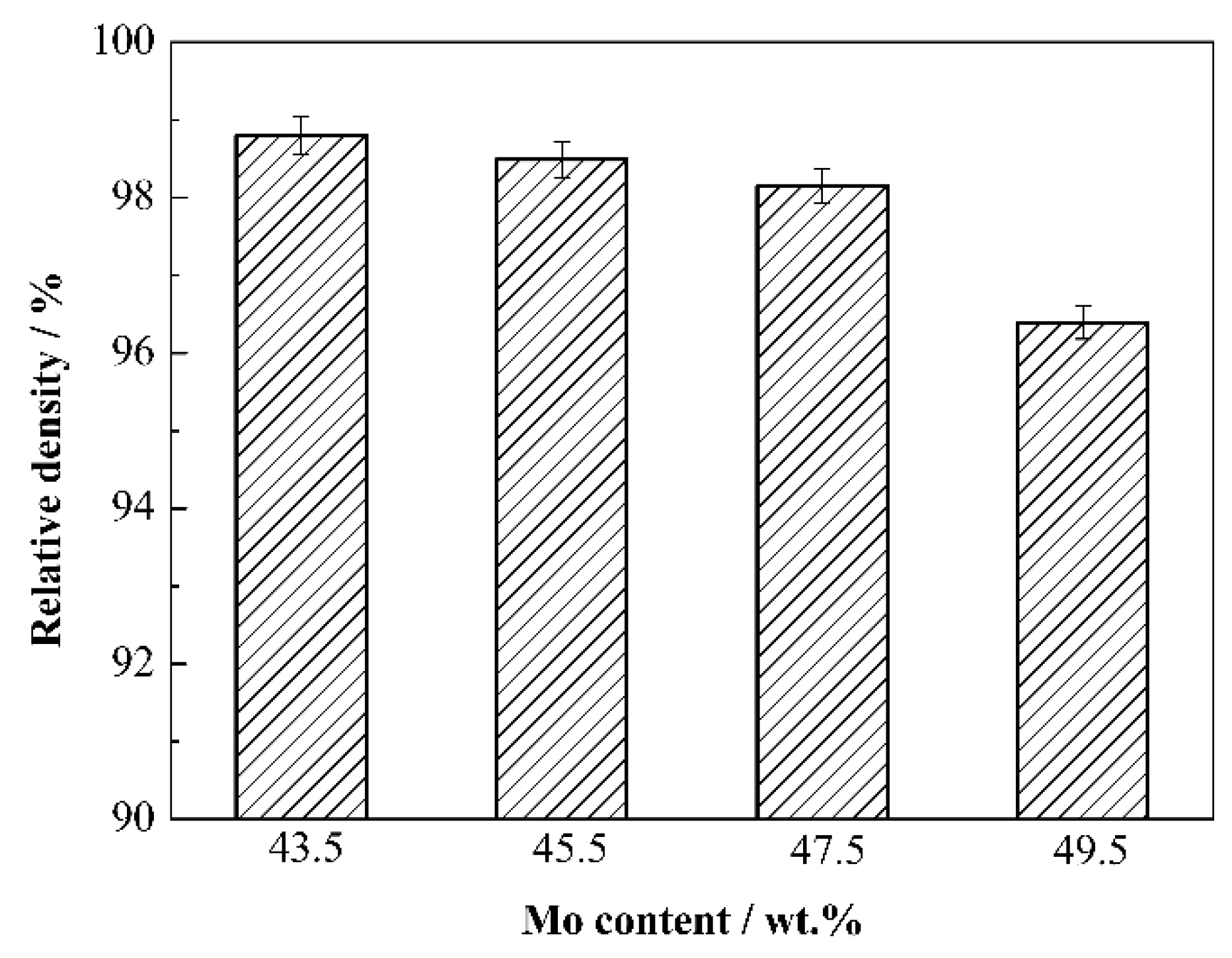

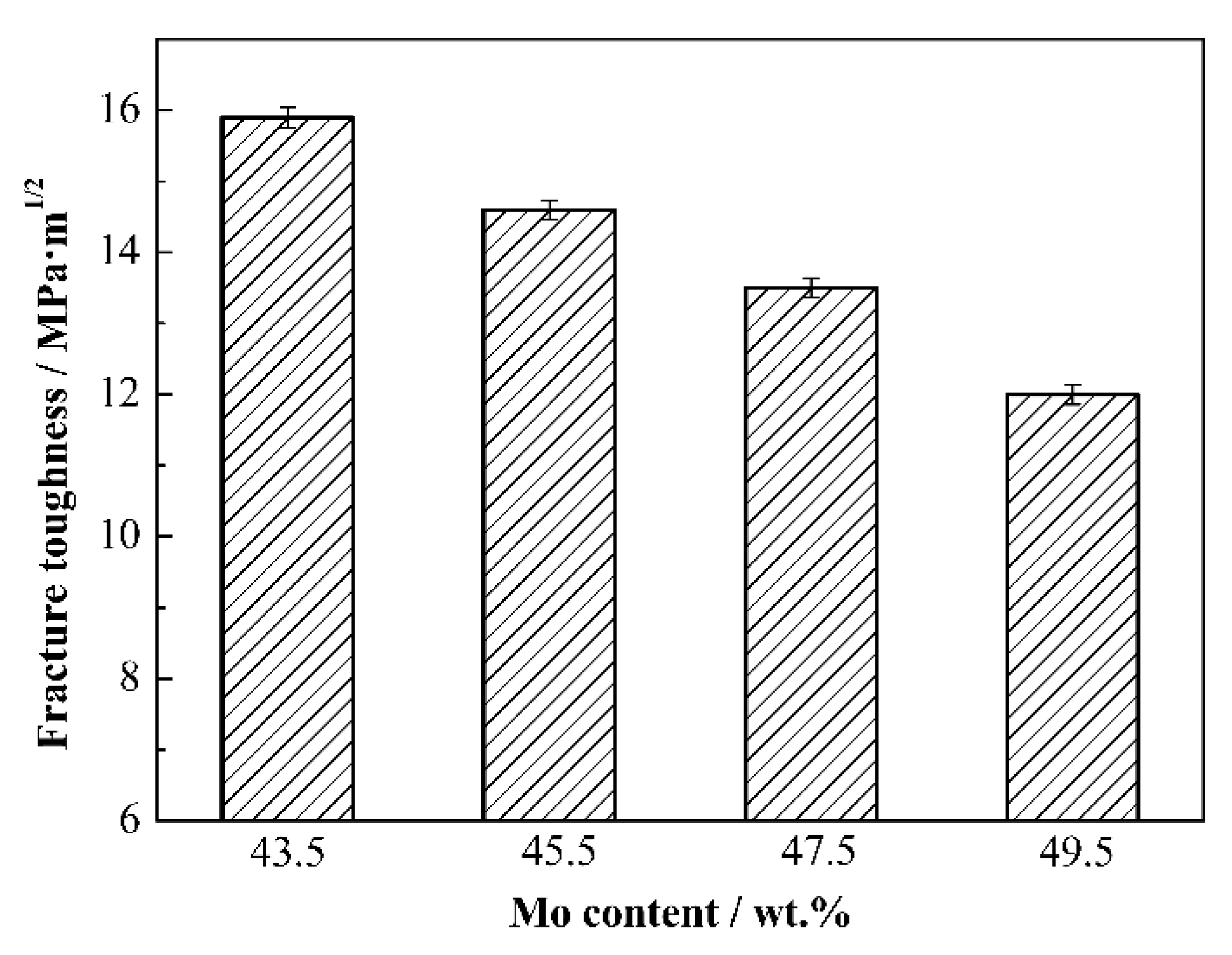
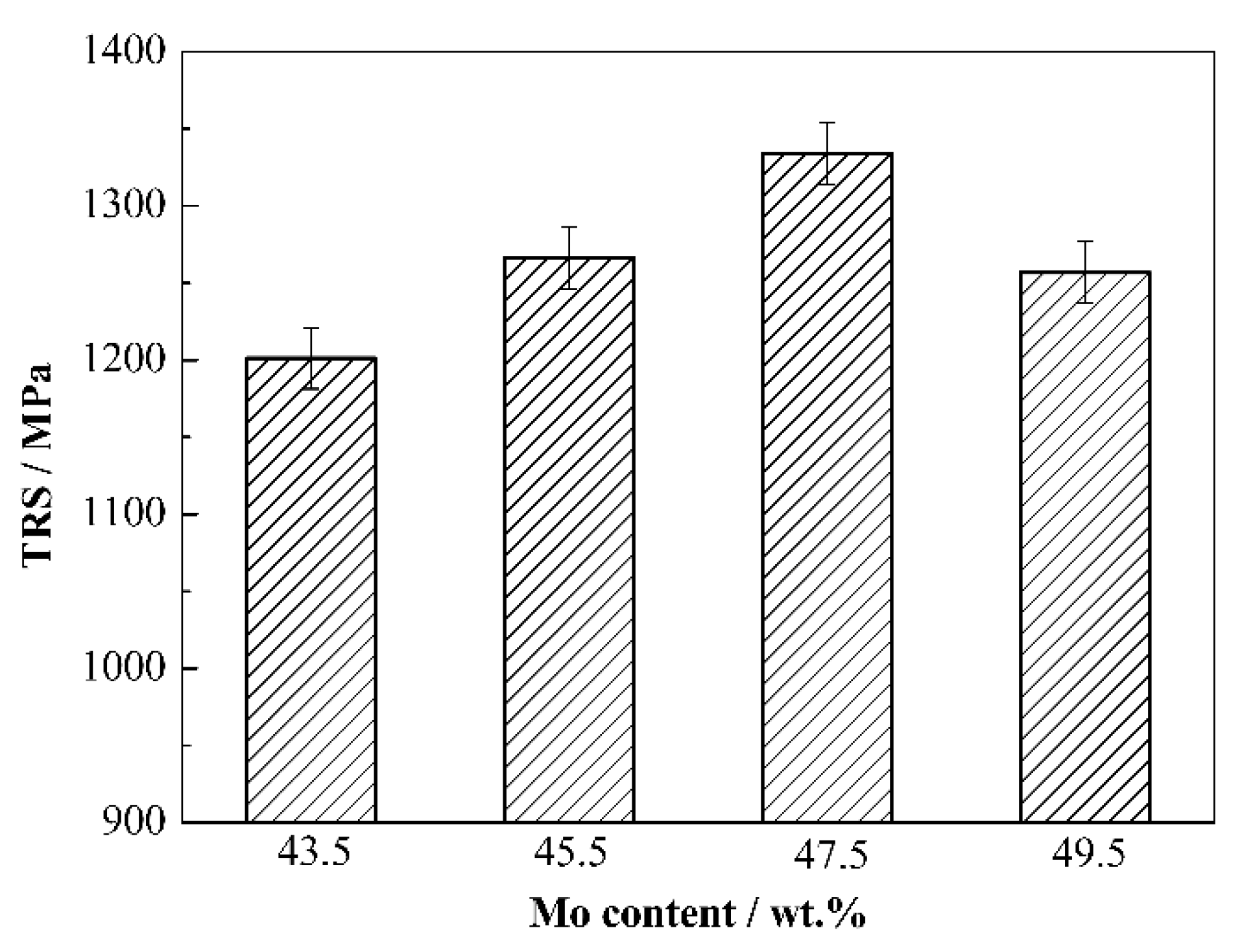
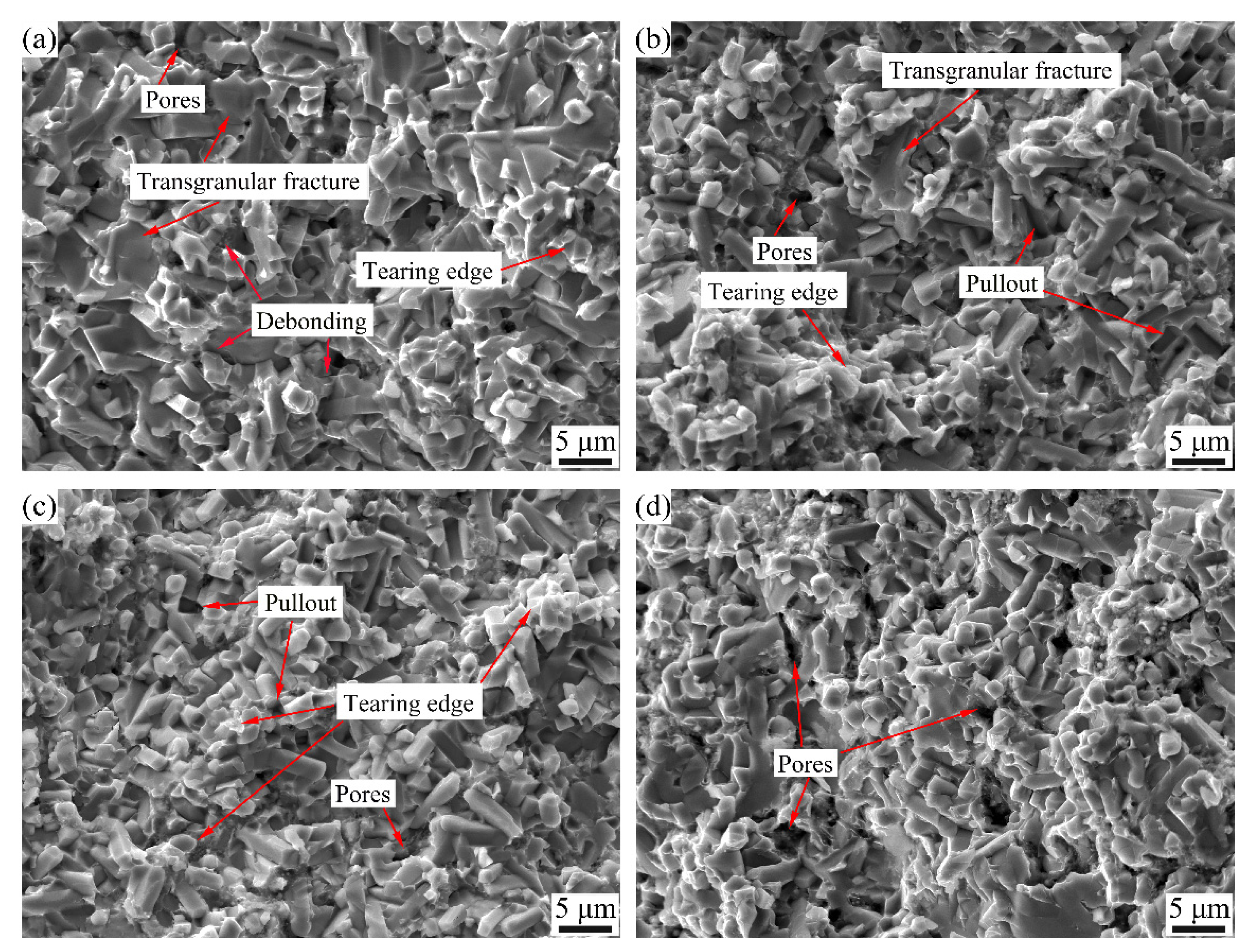
| Powder | Mean Particle Size (μm) | Chemical Composition (wt.%) | Manufacturer |
|---|---|---|---|
| Mo | 2 | Mo ≥ 99.95, Fe < 0.005, Si < 0.002 | Changsha Tianjiu Metal Material Corp., Ltd. of China |
| FeB | 45 | B = 20.05, Si < 0.36, C < 0.36 | |
| Fe | 5 | Fe ≥ 99.81, C < 0.015, O < 0.16 |
| Cermets | Mo | FeB | Fe |
|---|---|---|---|
| A | 43.5 | 27.5 | 29.0 |
| B | 45.5 | 28.7 | 25.8 |
| C | 47.5 | 30.0 | 22.5 |
| D | 49.5 | 31.3 | 19.2 |
Publisher’s Note: MDPI stays neutral with regard to jurisdictional claims in published maps and institutional affiliations. |
© 2022 by the authors. Licensee MDPI, Basel, Switzerland. This article is an open access article distributed under the terms and conditions of the Creative Commons Attribution (CC BY) license (https://creativecommons.org/licenses/by/4.0/).
Share and Cite
Shen, Y.; Xie, W.; Sun, B.; Liu, Y.; Li, Y.; Cao, Z.; Jian, Y.; Huang, Z. Effect of Mo Content on In-Situ Anisometric Grains Growth and Mechanical Properties of Mo2FeB2-Based Cermets. Materials 2022, 15, 6729. https://doi.org/10.3390/ma15196729
Shen Y, Xie W, Sun B, Liu Y, Li Y, Cao Z, Jian Y, Huang Z. Effect of Mo Content on In-Situ Anisometric Grains Growth and Mechanical Properties of Mo2FeB2-Based Cermets. Materials. 2022; 15(19):6729. https://doi.org/10.3390/ma15196729
Chicago/Turabian StyleShen, Yupeng, Wuxi Xie, Bingbing Sun, Yunfei Liu, Yajin Li, Zhen Cao, Yongxin Jian, and Zhifu Huang. 2022. "Effect of Mo Content on In-Situ Anisometric Grains Growth and Mechanical Properties of Mo2FeB2-Based Cermets" Materials 15, no. 19: 6729. https://doi.org/10.3390/ma15196729




